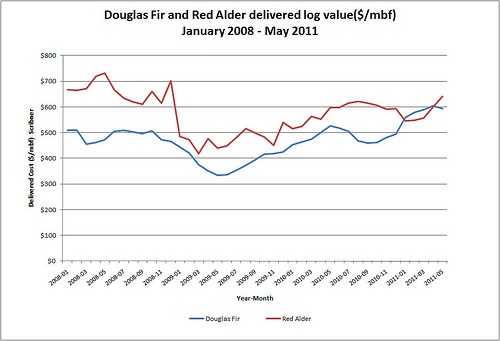2 min read
Hardwoods Growing Up: Now a Vital Part of the Northwest Forest Industry
 Gordon Culbertson
:
June 29, 2011
Gordon Culbertson
:
June 29, 2011

The Washington Hardwoods Commission (WHC) held their 2011 annual meeting on June 15 in Chehalis, Washington. Most of the Northwest’s leading authorities on the hardwood wood industry were in attendance. “Hardwood Supply in the Pacific NW” was an informative and valuable conference offering insight into Pacific Northwest hardwood forestry practice, intensive management, timber supply projections and promotion of hardwood products in today’s consumer marketplace.
Much of the WHC conference focused on improved red alder management. Red alder is the most common and highly sought after commercial hardwood species in the region. This native species grows most successfully on moist sites in the coastal mountains. High quality red alder lumber is used for furniture, cabinets and turning. Its light color, pleasing appearance and unique ability to accept a variety of stains allow it to imitate many species. The lower quality wood is commonly used for pallets and pulp chips.
For many years red alder was a “come along species,” typically harvested in conjunction with more valuable conifer logs. Though it was long overshadowed by Douglas fir, red alder has come into its own in recent years. Recognized for its value in secondary manufacturing, alder log values have proven to be resilient during periods of weak demand for other Northwest timber species. The following chart compares Douglas fir and alder log values.
Red alder is a very attractive forestry option for landowners large and small. With good site preparation, planting stock and thinning, forest owners can harvest a valuable commercial timber crop in as little as thirty years. However as the WHC program highlighted, there are definitely challenges to a successful hardwood management regime. Streamside forest practice rules enacted to protect aquatic resources have restricted some of the best alder growing sites and reduced harvest availability on state and private forestlands. Several speakers representing government and private viewpoints explored how timber owners may improve utilization of hardwood timber resources while meeting stream protection objectives.
Hardwood forest resources are not limited to the coast. Also highlighted at the conference was an intensively managed major hardwood operation on the dry side of the mountains. Greenwood Resources manages an 18,500 acre fiber farm near Boardman in Morrow County, Oregon. This arid site along the Columbia River features one of the largest contiguous drip irrigated farms in the world. Actually, their water distribution system is the second largest in Oregon, behind only the city of Portland.
Greenwood grows hybrid poplar on twelve-year rotations, supplying the Pacific Albus sawmill, operated by the Collins Companies in Boardman. The sawmill produces high quality lumber for furniture, millwork and other applications. In addition, Greenwood sends woodchips to several pulp and paper mills and now biomass recovered from limbs and tops is delivered to the new ZeaChem cellulosic ethanol bio-refinery.
Pacific Northwest hardwoods have certainly come a long way. Just a few decades ago they were commonly eradicated as “weeds” competing with more desirable conifers. A testament to the hard work of the WHC and others, hardwood forestry and manufacturing operations now share the spotlight as a fast growing and valuable timber asset.
Comments
07-06-2011
The red Alder in Oregon is hard to sell locally, I live 70 miles SW of Portland.
There is a mill in Eugene and one north of Tillamook at Garibaldi both mills are owned by Weyerhaeuser and because they export they can not buy state or federal timber.
The Forest Service and BLM have been selling their red alder for firewood not because of Weyerhaeuser it is due to the spotted owl. The Hebo Forest Service office has not sold a timber sale of any kind in 20 years yet the Hebo office is still to this day fully staffed. I don’t think they sell enough firewood permits to pay the salary’s of the 20 or more employees that work or what ever it is that they do there at Hebo.
Yours Truly Don Davis ‘




